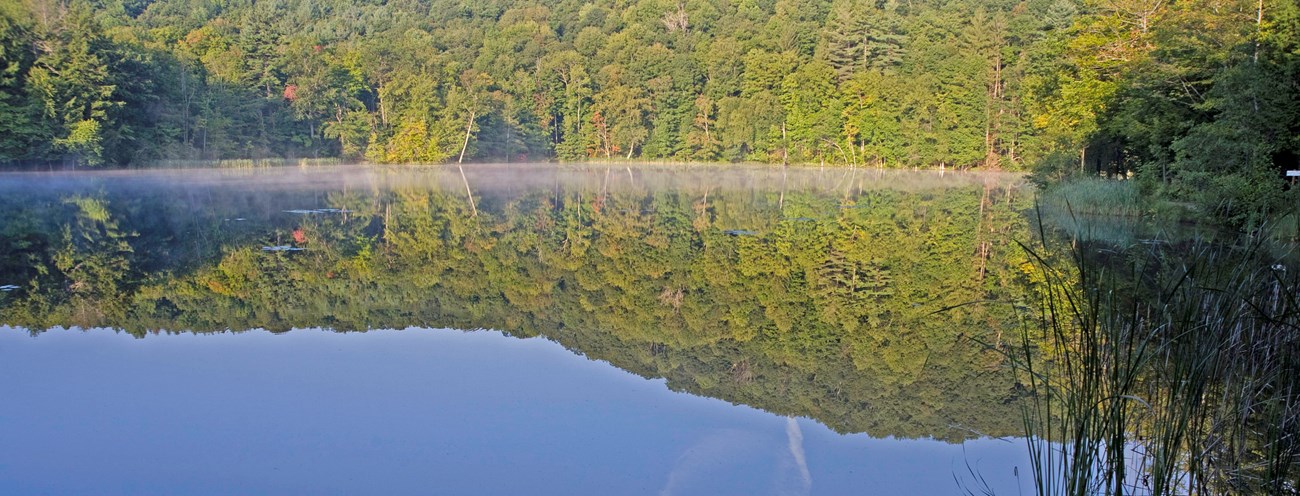
Ed Sharron photo. OverviewMarsh-Billings-Rockefeller National Historical Park encompasses the historic Marsh-Billings-Rockefeller Mansion, the surrounding grounds, and the Mount Tom Forest in Woodstock, Vermont. It was a gift to the people of the United States from Mary French and Laurance S. Rockefeller. Mary Rockefeller's grandfather, Frederick Billings, developed the property into a model farm and forest in the late 1800s. Billings' stewardship efforts were influenced by George Perkins Marsh. A conservationist and author of the 1864 landmark book Man and Nature, Marsh spent his childhood years on the property. Geology and geologic processes form the foundation for the ecosystem at Marsh-Billings-Rockefeller National Historical Park and continue to influence the evolution of the landscape. The park contains metamorphosed rocks formed more than 400 million years ago, originally deposited in an ancient ocean basin. Sitting atop this ancient bedrock, today the bulk of the park consists of a northen hardwood forest ecosystem that provides habitat for a wide variety of wildlife, including over 165 species of birds. The park also contains a year-round stream (Pogue Brook) and pond (The Pogue), which are both monitored under NETN's water quality monitoring program. Long Term Monitoring Programs in the ParkSource: Data Store Saved Search 1187. To search for additional information, visit the Data Store. Source: Data Store Saved Search 2272. To search for additional information, visit the Data Store. Source: Data Store Saved Search 1189 (results presented are a subset). To search for additional information, visit the Data Store. Source: Data Store Saved Search 1062. To search for additional information, visit the Data Store. Park Basline InventoriesThe Inventory and Monitoring Program provides guidance, funding, and technical assistance for parks to complete a set of 12 baseline, or "basic", natural resource inventories. These basic inventories are common to all parks with significant natural resources, and are intended to provide park managers with the minimum information needed to effectively manage the natural resources of their park.
Park Species ListsSpecies lists are available from NPSpecies, the National Park Service's tool for documenting park biodiversity. Keep in mind that these species lists are a work-in-progress. Changes and updates are made as more species are shepherded through a rigorous vetting process. The absence of a species from a list produced with the tool below doesn't necessarily mean the species is absent from a park.Select a Park:Select a Species Category (optional):
Search results will be displayed here.
Natural Resource Briefs for Marsh-Billings-Rockefeller NHPClick link below to view all the short briefs about the long-term monitoring and natural resouces of the park.Source: Data Store Saved Search 3743. To search for additional information, visit the Data Store. Non NPS Citizen Science Opportunities in the ParkBird observations from eBirdMarsh-Billings-Rockefeller NHP has been set up in eBird as a birding "hotspot". Help the park bolster bird data by adding your bird obsevations to eBird when you visit the park.You can also download and print off a Bird Checklist for the park. The bird list was created using data from the volunteer run NETN Breeding Landbird Monitoring program, eBird observations, and NPSpecies information. Species observations from iNaturalistLearn how you can contribute to iNaturalist View Marsh-Billings-Rockefeller NHP data on iNaturalist website Park Science Stories |
Last updated: February 15, 2022
